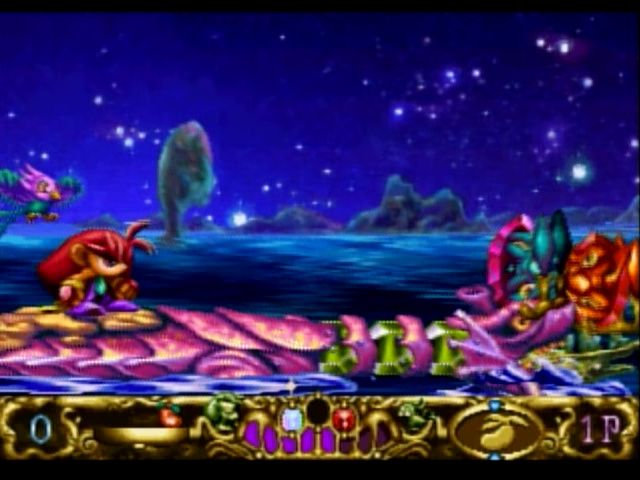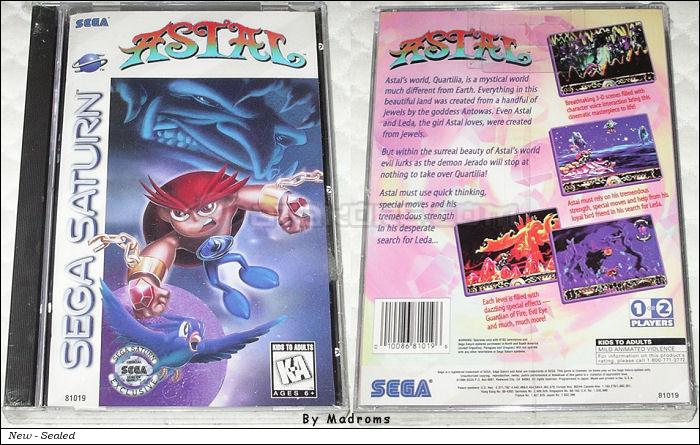| Astal | |
|---|---|
| Developer(s) | Sega |
| Publisher(s) | Sega |
| Director(s) | Masahito Shimizu |
| Producer(s) | Makoto Oshitani |
| Designer(s) | Tsuyoshi Sugai Masahito Shimizu |
| Artist(s) | Mika Okada |
| Writer(s) | Motomu Hayashi Toshiyasu Kamiko |
| Composer(s) | Tatsuyuki Maeda Tatsuya Kousaki |
| Platform(s) | Sega Saturn |
| Release |
|
| Genre(s) | Platformer |
| Mode(s) | Single-player, multiplayer |
The launch of their Saturn console marks one of Sega’s biggest fumbles of all time. Not only was there very little software available, but arcade ports like Virtua Fighter and Daytona USA were rushed and underwhelming. Worse yet Sega didn’t have a Sonic title for the system during its entire lifespan. #Astal #Sega #retro #Saturn. Game Astal; 1995; Category Gaming; Show more Show less. Hide chat Show chat. Autoplay When autoplay is enabled, a suggested video will automatically play next.
Astal[a] is a 2Dside scrollingplatformer game for the Sega Saturn. Astal was released early in the Sega Saturn's life and used hand-drawn graphics. The animations for the cutscenes were provided by TMS Entertainment.
Gameplay[edit]

The player controls Astal through a side-scrolling world. Astal's primary mode of attacking is using the B Button on the Gamepad. Pressed without direction, or with left or right held down, Astal will grab and throw enemies or objects over his shoulder. Pressed while holding down, Astal will punch the ground, stunning enemies. Pressed while jumping (via using the C button), he will punch down with both fists. The B Button is also used to lift certain pieces of scenery, such as trees or boulders, and throw them. Astal's final method of attack is blowing. Pressing up on the D-pad will allow him to inhale air, and holding forward and pressing B immediately after will blow this air out, literally blowing away all enemies directly in front of him.
Within each level are a number of glowing enemies. Defeating them charges a meter in Astal's HUD located at the bottom of the screen. When A, X, Y or Z is pressed the bird will pinball around the screen, retrieving items and killing enemies.
Astal also includes a two-Player cooperative mode, with a second player controlling the bird. The bird can strike at the enemy with wings and beak using the B button, launch an arrow attack by holding down and then releasing the B button, or dive bomb the enemy by pressing and holding the C button while using left and right on the D-pad to control direction. The bird can also dash across the screen by pressing left or right twice and holding.
Story[edit]
Somewhere in the universe, the Goddess Antowas created a world from a single jewel. On this world, Quartilia, she created the sky, earth, and air. To inhabit this world, she created two humans - from a green jewel, a girl: Leda, who has the power to make things live on Quartilia. And from a red Jewel, a boy: Astal, whose purpose was to protect Leda. Content with her creation, Antowas slept.
While she slept, the evil Jerado tried to take over Quartilia. To ensure victory, Jerado created a warrior: Geist. Geist kidnapped Leda, and held her at the bottom of the ocean. In an effort to get her back, Astal tore Quartilia apart, awakening Antowas. As punishment, Antowas banished Astal to Quartilia's moon. Leda took pity on Astal, and gave him her jewel. Once Astal and Jerado were dealt with, Antowas went back to sleep.
However, Geist was still free, and Quartilia was not restored from the changes Jerado wrought. From his prison on the moon, Astal witnessed Geist kidnap Leda again. Consumed with the need to protect her, he freed himself and returned to Quartilia. Now Astal journeys in search of Leda through a Quartilia transformed by Jerado's dark design, along with a strange bird who for some reason just won't leave him alone...
Localization[edit]
The game had a number of differences between its Japanese and English language releases. In the Japanese version, Astal has five life points and unlimited continues. This was dropped to three life points and one continue in the North American version. In the Japanese version, the song 'Let Me Try Again' that plays during the game's intro movie includes vocals. The North American version is instrumental. However, the vocal version can be heard by playing the game's CD in a standard CD player.
The Japanese voice cast had the titular character being voiced by Ai Orikasa, Leda, Yuri Shiratori, with Antowas and the Narrator being played by Aya Hisakawa, Geist being played by Ryo Horikawa, and Jerado, Daisuke Gōri. The monsters were voiced by Saori Wada, Toshiyasu Kamiko, Naoko Hamada, and Yasumaru Hotta. All voices in the North American version are performed by Lani Minella, who has voiced many different video game characters in her career, including Rouge the Bat and Omochao in Sega's Sonic Adventure 2 and Sonic Heroes.
Reception[edit]
On release, Famicom Tsūshin scored Astal 24 out of 40.[1]GamePro criticized the game's visual aesthetic, saying that 'The beautifully drawn graphics are charming, but unfortunately they're charming in the style of those round-eyed-waif paintings.' The reviewer added that the challenge would be too frustrating for children, and that the short stages leave the game with little longevity. He concluded that while it 'strengthens the Saturn's platform potential', Astal is merely 'A good rental'.[2]Electric Playground gave it 8 out of 10.[3]Jennifer Diane Reitz reviewed the game positively but criticized it for being too short and having a limited number of actions available to players. Reitz summarized Astal as 'Exquisitely beautiful, lovely, wonderful fare. It is too short... but Astal is one hell of a ride while it lasts. A rare, but slightly flawed gem.'[4]

IGN staff writer Levi Buchanan ranked Astal ninth in his list of the top 10 Sega Saturn games, noting that 'The game came out early in the Saturn's lifespan and was largely ignored -- no thanks to the garish box art. But those that did take Astal home cherished this beautiful example of a fading genre.'[5] However, another IGN writer gave it a 3 out of 10 and called it 'crappy' and 'derivative' albeit with 'pretty graphics'.[6]
Next Generation rated it three stars out of five, and stated that 'Astal is, in the end, a fine, side-scrolling action game, and if you already own a Saturn and you love side-scrolling action games, then this is a good one to pursue, but this game would not exactly make a good argument for buying a 32-bit machine.'[7]
Legacy[edit]
Astal Saturn
Astal often makes cameo appearances (usually in background shots, architecture, or large group shots) in the Sonic The Hedgehog comic book series by Archie Comics, courtesy of artist Patrick Spaziante. Astal (and the bird) have a one panel cameo in Sonic the Hedgehog issue #50. They appear alongside Bark the Polar Bear, Bean the Dynamite, Ray the Flying Squirrel, Ristar, and Deku from Fighters Megamix fighting against the Overlanders (Humans) in a flashback/dream sequence of Dr. Robotnik. On the cover of #51, Astal appears in the audience, looking up to Sonic, Tails, and Princess Sally standing on the podium and celebrating their victory over Dr. Robotnik. On the cover of #125, he is behind the '5' card held by Mighty the Armadillo. He is also on the covers of Sonic Super Special Nos. 5[1] and 9[2], as a doll of Tails.
Notes[edit]
Sega Saturn Astal
- ^known in Japan as Kisuishou Densetsu Astal (輝水晶伝説 アスタル, lit. 'Shining Crystal Legend Astal')
References[edit]
- ^NEW GAMES CROSS REVIEW: 輝水晶伝説アスタル. Weekly Famicom Tsūshin. No.333. Pg.32. 5 May 1995.
- ^Scary Larry (November 1995). 'ProReview: Astal'. GamePro. No. 86. IDG. p. 60.
- ^'Astal for Saturn - GameRankings'. GameRankings. Retrieved 2013-04-04.
- ^Reitz, Jennifer (1995-12-25). 'Jennifer Reitz Review 'Astal''. Retrieved 2013-04-04.
- ^Buchanan, Levi (2008-07-29). 'Top 10 SEGA Saturn Games'. IGN. Retrieved 2013-04-03.
- ^'Astal - IGN'. IGN. 1998-01-02. Retrieved 2013-04-04.
- ^'Finals'. Next Generation. No. 9. Imagine Media. September 1995. p. 88.
External links[edit]
- 'Astal at Sega Saturn Magazine'. Archived from the original on 2005-12-16. Retrieved 2006-02-20.Cite uses deprecated parameter
deadurl=(help)